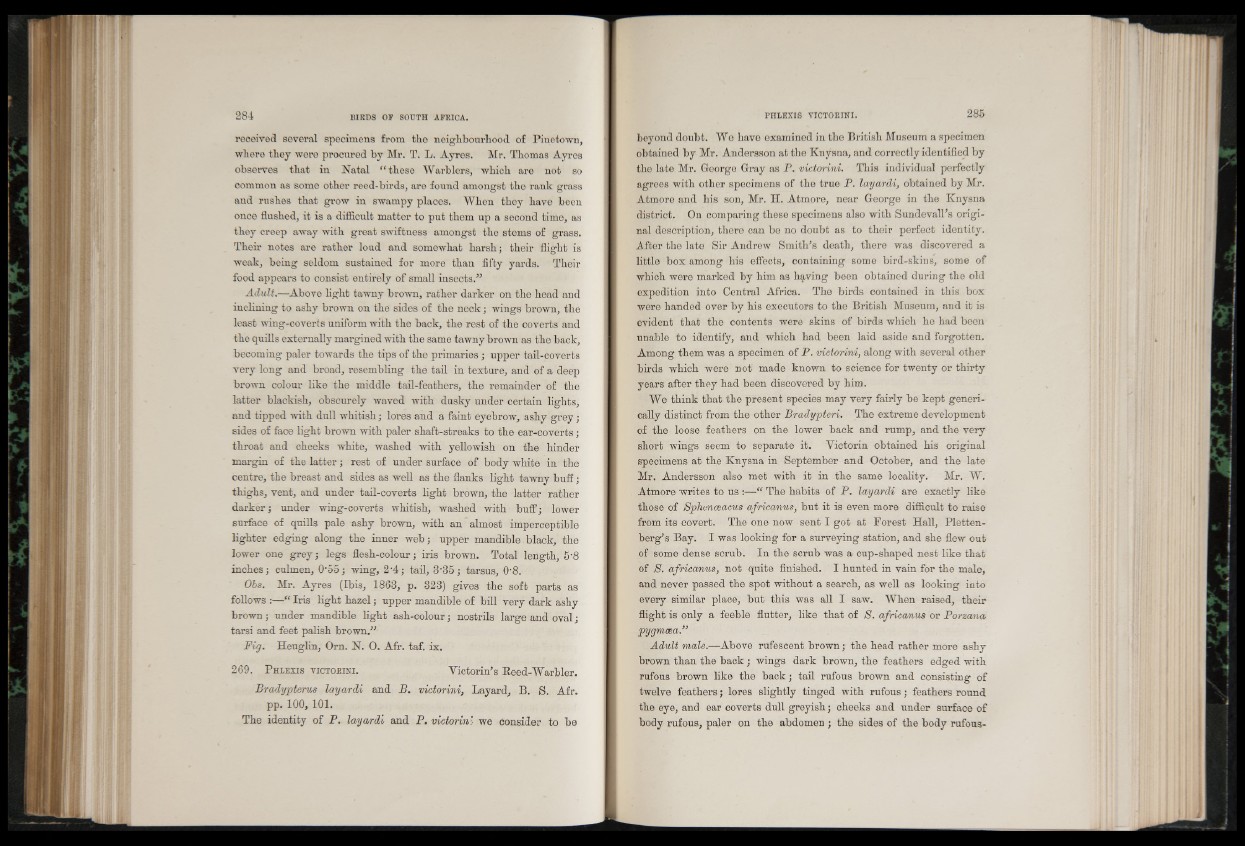
received several specimens from the neighbourhood of Piuetown,
where they were procured by Mr. T. L. Ayres. Mr. Thomas Ayres
observes that in Natal “ these Warblers, which are not so
common as some other reed-birds, are found amongst the rank grass
and rushes that grow in swampy places. When they have been
once flushed, it is a difficult matter to put them up a second time, as
they creep away with great swiftness amongst the stems of grass.
Their notes are rather loud and somewhat harsh; their flight is
weak, being seldom sustained for more than fifty yards. Their
food appears to consist entirely of small insects.”
Adult.—Above light tawny brown, rather darker on the head and
inclining to ashy brown on the sides of the neck; wings brown, the
least wing-coverts uniform with the back, the rest of the coverts and
the quills externally margined with the same tawny brown as the back,
becoming paler towards the tips of the primaries ; upper tail-coverts
very long and broad, resembling the tail in texture, and of a deep
brown colour like the middle tail-feathers, the remainder of the
latter blackish, obscurely waved with dusky under certain lights,
and tipped with dull whitish; lores and a faint eyebrow, ashy grey;
sides of face light brown with paler shaft-streaks to the ear-coverts;
throat and cheeks white, washed with yellowish on the hinder
margin of the latter; rest of under surface of body white in the
centre, the breast and sides as well as the flanks light tawny buff;
thighs, vent, and under tail-coverts light brown, the latter rather
darker; under wing-coverts whitish, washed with buff; lower
surface of quills pale ashy brown, with an almost imperceptible
lighter edging along the inner web; upper mandible black, the
lower one grey; legs flesh-colour; iris brown. Total length, 5'8
inches; cnlmen, 0‘55; wing, 2‘4; tail, 3‘35; tarsus, 0‘8.
Obs. Mr. Ayres (Ibis, 1863, p. 323) gives the soft parts as
follows :—“ Iris light hazel; upper mandible of bill very dark ashy
brown; under mandible light ash-colour; nostrils large and oval;
tarsi and feet palish brown.”
Fig. Heuglin, Orn. N. 0. Afr. taf. ix.
2 6 9 . P h l ex is v ic t o r in i. Victoria's Reed-Warbler.
Bradypterus layardi and B. victorini, Layard, B. S. Afr.
p p . 1 0 0 , 1 0 1 .
The identity of P. layardi and P. victorini we Consider to be
beyond doubt. We have examined in the British Museum a specimen
obtained by Mr. Andersson at the Knysna, and correctly identified by
the late Mr. George Gray as P. victorini. This individual perfectly
agrees with other specimens of the true P. layardi, obtained by Mr.
Atmore and his son, Mr. H. Atmore, near George in the Knysna
district. On comparing these specimens also with Sundevall's original
description, there can be no doubt as to their perfect identity.
After the late Sir Andrew Smith's death, there was discovered a
little box among his effects, containing some bird-skins, some of
which were marked by him as having been obtained during the old
expedition into Central Africa. The birds contained in this box
were handed over by his executors to the British Museum, and it is
evident that the contents were skins of birds which he had been
unable to identify, and which had been laid aside and forgotten.
Among them was a specimen of P. victorini, along with several other
birds which were not made known to science for twenty or thirty
years after they had been discovered by him.
We think that the present species may very fairly be kept generi-
cally distinct from the other Bradypteri. The extreme development
of the loose feathers on the lower back and rump, and the very
Bhort wings seem to separate it. Victorin obtained his original
specimens at the Knysna in September and October, and the late
Mr. Andersson also met with it in the same locality. Mr. W.
Atmore writes to us :—“ The habits of P. layardi are exactly like
those of Sphenceacus africanus, but it is even more difficult to raise
from its covert. The one now sent I got at Forest Hall, Pletten-
berg's Bay. I was looking for a surveying station, and she flew out
of some dense scrub. In the scrub was a cup-shaped nest like that
of S. africanus, not quite finished. I hunted in vain for the male,
and never passed the spot without a search, as well as looking into
every similar place, but this was all I saw. When raised, their
flight is only a feeble flutter, like that of 8. africanus or Porzana
pygmcea.”
Adult male.—Above rufescent brown; the head rather more ashy
brown than the back ; wings dark brown, the feathers edged with
rufous brown like the back; tail rufous brown and consisting of
twelve feathers; lores slightly tinged with rufous; feathers round
the eye, and ear coverts dull greyish; cheeks and under surface of
body rufous, paler on the abdomen ; the sides of the body rufous